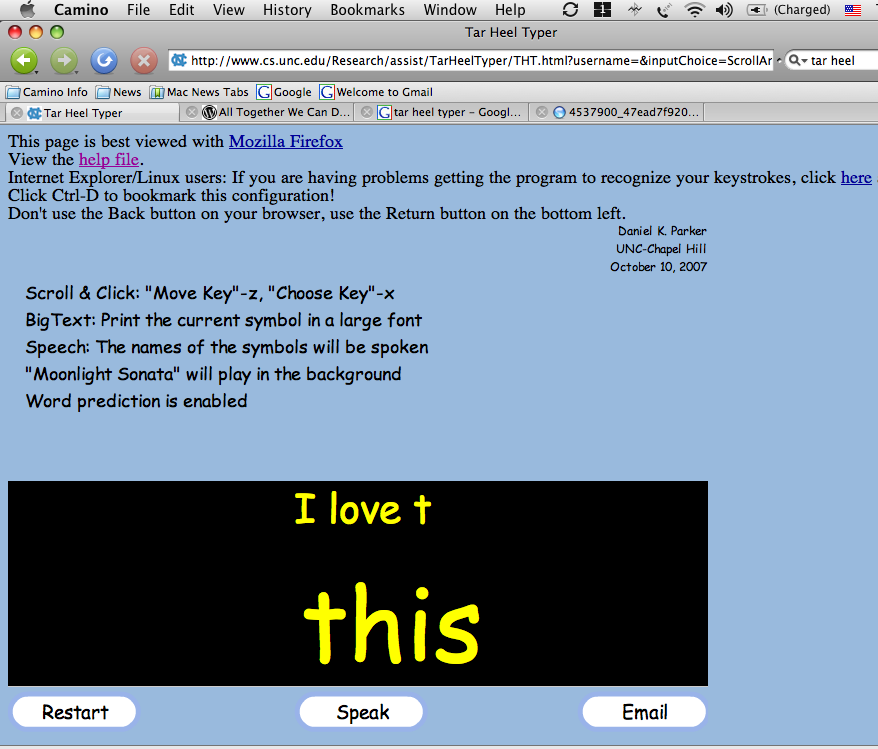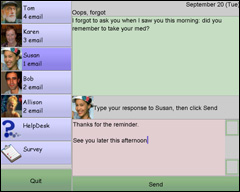 I was fifteen when I first talked with someone using AAC. At the time I had no idea what AAC was, I just knew that my favorite period of the school day was service learning. My service learning assignment was in the "severe special needs" classroom in the large suburban high school I attended. I started volunteering one period a day my sophomore year and by my senior year I would spend up to three periods a day and be president of "Outreach", a club similar to "Best Buddies" before "Best Buddies" existed.
I was fifteen when I first talked with someone using AAC. At the time I had no idea what AAC was, I just knew that my favorite period of the school day was service learning. My service learning assignment was in the "severe special needs" classroom in the large suburban high school I attended. I started volunteering one period a day my sophomore year and by my senior year I would spend up to three periods a day and be president of "Outreach", a club similar to "Best Buddies" before "Best Buddies" existed.My friend who used AAC was a few years older than me, and at first used a communication board attached to his wheelchair lap tray. He had a number of things he loved to say, like, "you. bus. mine." when he wanted me to come hang out at his house or, "you. wedding. me" during his daily wedding proposals. His communication board used black and white Mayer-Johnson symbols that were photocopied from a big book, cut out, arranged and mounted. (All you "old timers remember all that copying, cutting and coloring by hand - Boardmaker 1.0 was such a revelation.) He and I hung out all the time at school and had a great time. I remember in particular putting on my roller blades during a school dance and pushing his wheelchair around the dance floor. Later he would get a light talker, it used minspeak (which he couldn't figure out) and he had to grip a glowing wand to activate series of pictures to make phrases. The speech quality was horrendous and both he and I were much more comfortable conversing in what I now know as "manual communication" and "partner assisted scanning". Eventually I would become his PCA and then his camp counselor and overtime we reached that level of communication that so many of our students have with those they are close to, where half of a gesture relates a whole sentence. Yet, I know we would have never been friends if not for his manual communication board on his tray and the power of AAC that gave him a voice to chat, joke and flirt.
 The summer between sophomore and junior year of high school I worked at the state muscular dystrophy summer camp and had a little girl in my cabin who sealed my commitment to being a special education teacher of students with multiple disabilities, especially those who communicated without speaking. She was a cute little kid, the only child at camp who did not speak and one of the few who could walk. She communicated using what had to have been one of the first Dynavox devices ever, adapted sign language and vocalizations. On the third night of camp she grew home sick, crawling onto my bunk and signing, "mom" repeatedly. I had no idea how to use her "talking box" but I wrestled it out of the case and took it and her to the camp office where I plugged it in and watched as she used it to talk with her mother over the phone. When she said, "I love you, mom!" I was hooked, why didn't all of the people in the world who could not speak have these things?
The summer between sophomore and junior year of high school I worked at the state muscular dystrophy summer camp and had a little girl in my cabin who sealed my commitment to being a special education teacher of students with multiple disabilities, especially those who communicated without speaking. She was a cute little kid, the only child at camp who did not speak and one of the few who could walk. She communicated using what had to have been one of the first Dynavox devices ever, adapted sign language and vocalizations. On the third night of camp she grew home sick, crawling onto my bunk and signing, "mom" repeatedly. I had no idea how to use her "talking box" but I wrestled it out of the case and took it and her to the camp office where I plugged it in and watched as she used it to talk with her mother over the phone. When she said, "I love you, mom!" I was hooked, why didn't all of the people in the world who could not speak have these things?That winter I would write an essay about the experience that would secure my place at Simmons College in the intensive special needs undergraduate program (which no longer exists). I would take every elective relating to speech and communication and go off of the college's list of pre-practicum and practicum placements to find schools that worked with students who used AAC.
Even now with a roomful of students using AAC I think about the two people who taught me that just because someone can't speak, doesn't mean they don't have anything to say.
















































